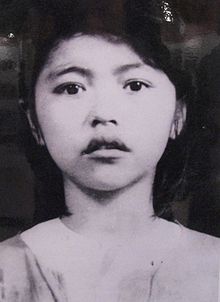| Võ Thị Sáu | |
|---|---|
 Portrait of Võ Thị Sáu at the Vung Tau Police Office. Portrait of Võ Thị Sáu at the Vung Tau Police Office. | |
| Born | 1933 Phước Thọ, Đất Đỏ, French Indochina |
| Died | 23 January 1952(1952-01-23) (aged 18–19) Côn Sơn Prison, Côn Sơn Island, Vietnam |
| Cause of death | Execution by firing squad |
| Nationality | Vietnamese |
| Occupation(s) | Nationalist guerrilla, schoolgirl |
| Years active | 1948–1952 |
| Known for | Anti-French guerilla combat, political martyrdom |
Võ Thị Sáu (1933 – 23 January 1952) was a Vietnamese schoolgirl who fought as a guerrilla against the French occupiers of Vietnam, then part of French Indochina. She was captured, tried, convicted, and executed by the French colonialists in 1952, becoming the first woman to be executed at Côn Sơn Prison. Today she is considered a Vietnamese national martyr and heroine.
Biography
She was born in Phước Thọ Commune, Đất Đỏ District, in 1933. At the time, this was part of Bà Rịa Province, but today is a part of Long Đất District, Bà Rịa–Vũng Tàu province. In 1948, she became a contact for a local guerrilla group after many of her friends and family joined the Việt Minh.
When she was 14 she threw a grenade at a group of French soldiers in the crowded market area, killing 1 of them and injuring 12. She escaped undetected. Late in 1949, she threw another grenade at a Vietnamese canton chief — a local man responsible for executing many suspected Việt Minh sympathizers. The grenade failed to explode, and she was caught by the French authorities.

Sáu was imprisoned in three different facilities, the last of which was a police post near Côn Sơn Prison in the Côn Đảo Islands. She was executed on 23 January 1952, at the age of 18 by firing squad in the corner of Bagne III; upon being offered a blindfold she refused stating that she wishes to “see her beloved country until the moment of death”.
Today, Sáu is considered a nationalist martyr and a symbol of revolutionary spirit. She is venerated by the Vietnamese people as an ancestral spirit, and has amassed almost a cult-like following of devotees who venerate her grave in Hàng Dương Cemetery on Côn Sơn Island. There is also a temple dedicated to her in her hometown of Đất Đỏ. Many Vietnamese cities and towns also have streets and schools named after her.
See also
References
- Eager, Paige Whaley (2008). From Freedom Fighters to Terrorists: Women and Political Violence. p. 131.
One story in particular of Vo Thi Sau exemplifies the commitment of the women to the cause of national liberation. In 1948, after many of her friends and relatives joined the Resistance against the French, Sau became a courier and saboteur for a local guerrilla group....
- ^ Grace, Paul (1974). "Introduction". Vietnamese women in society and revolution. Vol. 1.
On March 13, 1952 the French executed a sixteen-year-old woman named Vo Thi Sau. She was being ... She was given a grenade with which she managed to kill a French captain and wound 12 French soldiers. Her action went undetected. Late in 1949, a Vietnamese collaborator who was the canton chief of the district managed to get the French to execute hundreds of young men suspected of being Viet Minh cadres right in the marketplace. Sau was given the responsibility of eliminating this traitor. Since ammunition was so scarce, she was given only one hand grenade. It did not explode and she was caught by the French authorities. She went through three jails and scores of....
- ^ Emmons, Ron (2012). Frommer's Vietnam: with Angkor War.
Perhaps the most tragically poignant story of Con Son's prisoners is that of Vo Thi Sau, executed by the French at 19 years of age for lobbing a grenade at French soldiers when she was only 14. These days there is something of a cult ....
- Bass, Thomas (2009). The Spy Who Loved Us. New York: PublicAffairs. p. 246.
- Eisner, Rivka Syd Matova (2008). Re-staging revolution and remembering toward change: National Liberation Front women perform prospective memory in Vietnam. The University of North Carolina at Chapel Hill. p. 287.
The Spirit of Vo Thi Sau – One of the other spirits lingering and listening in the room with us is that of the national martyr (let si) Vo Thi Sau. She is one of the most revered ancestral spirits in the lives of the performance group women. Vo Thi Sau ...
- 1933 births
- 1952 deaths
- People from Bà Rịa-Vũng Tàu province
- Executed juvenile offenders
- Executed revolutionaries
- Executed Vietnamese people
- Executed women
- Women in war 1945–1999
- Women in war in Vietnam
- People executed by the French Fourth Republic
- People executed by the French military by firing squad
- People executed for attempted murder